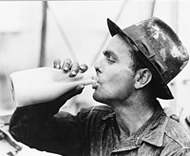
Milk is sold in glass bottles for the first time in the United States. It’s a clear improvement in hygiene and convenience.
Until that time, people bought milk as a bulk item, with the seller dispensing milk out of a keg or bucket into whatever jugs, pails, or other containers the customers brought. That practice left a lot to be desired on the cleanliness front. Echo Farms Dairy introduced the first purpose-made milk bottles in New York City, delivering the milk from Litchfield, Connecticut. Other dealers initially feared the expense of breakage, and some customers didn’t like the drugstore look of the containers.

But the new method of delivery eventually caught on. By the first decade of the twentieth century, some cities required that milk be delivered in glass bottles. The earliest wax containers appeared in the 1890s. Shapes ranged from simple boxes to cylinders to cones to truncated pyramids. Some even imitated the shape of a typical round glass bottle.
What finally prevailed in the 1940s was a rectangular-column design with a small, round pull-up cap on a flat top piece. The containers were lightweight and compact, wasting little space in milk trucks. Flat-top boxes were replaced in the 1950s by square cartons with gable tops that opened out into spouts for easy pouring. This design had actually been patented in 1915.
Milk in glass bottles is a specialty or niche product these days, and home milk delivery is pretty much a thing of the past. The wax gable-top design and the more recent plastic bottles account for nearly all the retail milk sold in the United States, and you have to go to the store to buy them.—RA